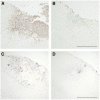Role of chemokines in CNS health and pathology: a focus on the CCL2/CCR2 and CXCL8/CXCR2 networks
- PMID: 19904283
- PMCID: PMC2949152
- DOI: 10.1038/jcbfm.2009.240
Role of chemokines in CNS health and pathology: a focus on the CCL2/CCR2 and CXCL8/CXCR2 networks
Abstract
Chemokines and their receptors have crucial roles in the trafficking of leukocytes, and are of particular interest in the context of the unique immune responses elicited in the central nervous system (CNS). The chemokine system CC ligand 2 (CCL2) with its receptor CC receptor 2 (CCR2), as well as the receptor CXCR2 and its multiple ligands CXCL1, CXCL2 and CXCL8, have been implicated in a wide range of neuropathologies, including trauma, ischemic injury and multiple sclerosis. This review aims to overview the current understanding of chemokines as mediators of leukocyte migration into the CNS under neuroinflammatory conditions. We will specifically focus on the involvement of two chemokine networks, namely CCL2/CCR2 and CXCL8/CXCR2, in promoting macrophage and neutrophil infiltration, respectively, into the lesioned parenchyma after focal traumatic brain injury. The constitutive brain expression of these chemokines and their receptors, including their recently identified roles in the modulation of neuroprotection, neurogenesis, and neurotransmission, will be discussed. In conclusion, the value of evidence obtained from the use of Ccl2- and Cxcr2-deficient mice will be reported, in the context of potential therapeutics inhibiting chemokine activity which are currently in clinical trial for various inflammatory diseases.
Figures



References
-
- Aloisi F, Care A, Borsellino G, Gallo P, Rosa S, Bassani A, Cabibbo A, Testa U, Levi G, Peschle C. Production of haemolymphopoietic cytokines (IL-6, IL-8 and colony-stimulating factors) by normal human astrocytes in response to IL-1β and tumor necrosis factor-α. J Immunol. 1992;149:2358–2366. - PubMed
-
- Andjelkovic AV, Song L, Dzenko KA, Cong H, Pachter JS. Functional expression of CCR2 by human fetal astrocytes. J Neurosci Res. 2002;70:219–231. - PubMed
-
- Araujo DM, Cotman CW. Trophic effects of interleukin-4, -7 and -8 on hippocampal neuronal cultures: potential involvement of glial-derived factors. Brain Res. 1993;600:49–55. - PubMed
Publication types
MeSH terms
Substances
LinkOut - more resources
Full Text Sources
Other Literature Sources
Molecular Biology Databases

